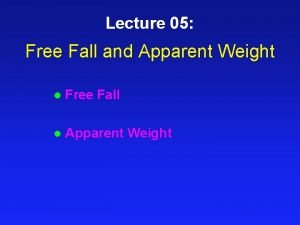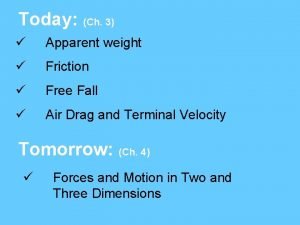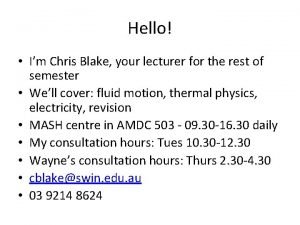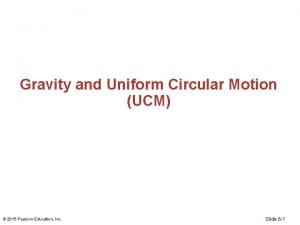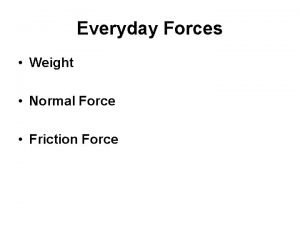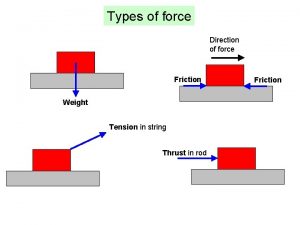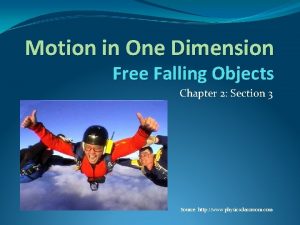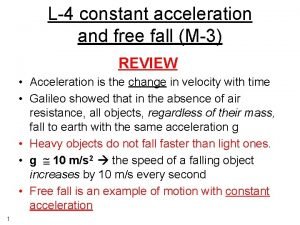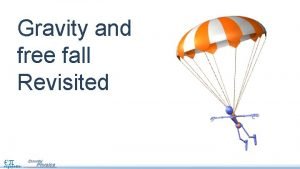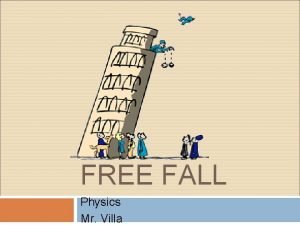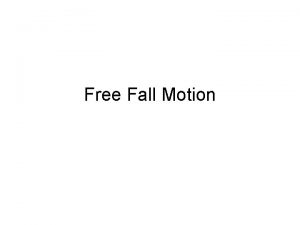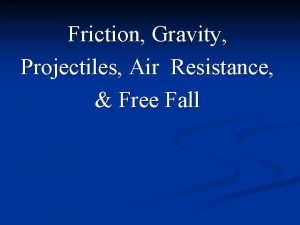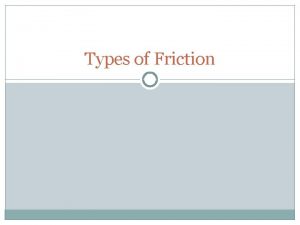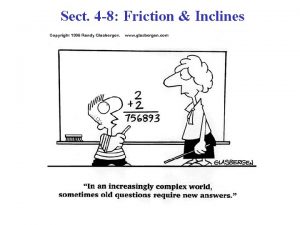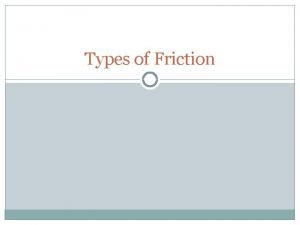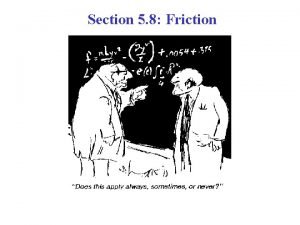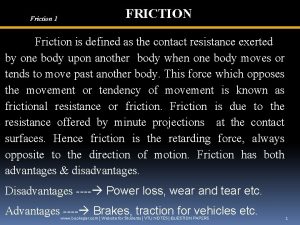Today Ch 3 Apparent weight Friction Free Fall

























- Slides: 25

Today: (Ch. 3) ü Apparent weight ü Friction ü Free Fall ü Air Drag and Terminal Velocity Tomorrow: (Ch. 4) ü Forces and Motion in Two and Three Dimensions

Elevators Why do you feel heavier or lighter sometimes when you are riding in an elevator?

Elevators There are 5 basic cases in the elevator: v moving up and speeding up v moving up and slowing down v moving down and speeding up v moving down and slowing down v moving up or down at a constant speed

Apparent Weight • The normal force is not always equal to the weight e. g. in elevator • Letting upward be positive: • ΣF = m a = N – mg N=ma+mg • If the elevator moved downward, N = m g – m a • The normal force is called the object’s apparent weight

Apparent weight

Example A passenger weighing 598 N rides in an elevator. The gravitational field strength is 9. 8 N/kg. What is the apparent weight of the passenger in each of the following situations? In each case the magnitude of elevator’s acceleration is 0. 5 m/s 2. (a) The passenger is on the 1 st floor and has pushed the button for the 15 th floor i. e. the elevator is beginning to move upward. (b) The elevator is slowing down as it nears the 15 th floor.

Friction • Friction can be – Kinetic • Related to moving – Static • When objects are at rest • The force of friction opposes the motion & the magnitude of the frictional force is related to the magnitude of the normal force • Force of kinetic friction – Ffriction = μk N – μk is called the coefficient of kinetic friction

Static Friction • |Ffriction | ≤ μs N – Static indicates that the two surfaces are not moving relative to each other • If the push is increased, the force of static friction also increases and again cancels the force of the push • The magnitude of the static friction has an upper limit of μs N – The magnitude of the force of static friction cannot be greater than this upper limit μs Coefficient of static friction

Kinetic Friction Vs Static Friction • Only difference is coefficients of friction • The force of kinetic friction is just Ffriction = μk N • Force of static friction given by |Ffriction | ≤ μs N • For a given combination of surfaces, generally μs > μk – It is more difficult to start something moving than it is to keep it moving once started

Example: Friction and Walking • The person “pushes” off during each step • Force exerted by the shoe on the ground : • If the shoes do not slip, the force is due to static friction – The shoes do not move relative to the ground • By Newton’s third law Reaction force : • If the surface was so slippery that there was no frictional force, the person would slip

Friction and Rolling • The car’s tire does not slip • There is a frictional force between the tire and road – • There is a reaction force on the tire –

Free Fall • A specific type of motion • Only gravity acts on the object – Some air drag, but it is generally considered negligible • Analyze the motion in terms of acceleration, velocity, and position

Free Fall – Acceleration • t = 0 be the instant after the object is released • Choose a coordinate system that measures position as the height y above the ground • Using Newton’s Second Law: – The negative sign comes from gravity acting downward

Free Fall – Velocity and Position • Velocity and position as functions of time: • The motion can be expressed graphically as well. Note the constant acceleration • The velocity and acceleration are not always in the same direction

Free Fall – Final Notes • The ball’s speed just before it hits the ground = initial speed – The velocities are in opposite directions • The time spent on the way up is equal to the time spent falling back down

Tension Example – Elevator Cable • Two forces: – Gravity acting downward – Tension in cable acting upward, T • Newton’s Second Law gives T = mg + ma • Assume massless cable • Applying Newton’s Second Law gives: TC = T • Tension has force units Upward Acceleration

Cables with Mass • Newton’s Second Law • The upper tension, T 1 must be larger than the tension from the box, T 2 • T 1 = T 2 + mcable g • If no acceleration • Can assume a massless cable if the mass of the cable is small compared to the other tensions present

Single & Multiple Pulleys

Air Drag • Air drag depends on speed & Area, so at higher speeds and area it becomes more of an effect • An estimate of air drag can be found by using – Fdrag = ½ ρ A v 2 • A more complete equation is – Fdrag = ½ CD ρ A v 2 – CD is the drag coefficient and depends on the aerodynamic shape – CD is 1 for boxy shapes and less than 1 for many streamlined shapes

Skydiving & Terminal Velocity • The skydiver will reach a constant velocity when Fdrag = Fgrav – Called the terminal velocity

Tomorrow: (Ch. 4) ü Forces and Motion in Two and Three Dimensions

Some Problem solving tips

Reasoning and Relationships-Problem Notes • We may need to identify important information that is “missing” from the initial description of the problem – We need to recognize that additional information is needed – Then make reasonable estimates of the “missing” quantities • An approximate mathematical solution and an approximate numerical answer are generally sufficient – The estimates of the “missing” values will vary from case to case

Reasoning and Relationships – Problem Solving Strategy • Recognize the principle – Determine the key physics ideas central to the problem – What principles connect the quantity you want to calculate with the quantities you know • Sketch the problem – Show all the given information – Draw a free body diagram, if needed • Include all the forces, velocities, etc. • Identify the relationships – Motion equations are an example of a set of relationships – If some values are unknown, make estimates for these values

Reasoning and Relationships – Problem Solving Strategy, cont. • Solve – An exact mathematical solution typically is not needed – Cast the problem into one that is easy to solve mathematically • Check – Consider what your answer means – Check to be sure the answer makes sense
 Apparent weight in free fall
Apparent weight in free fall Apparent weight
Apparent weight Formula for apparent weight
Formula for apparent weight How to find apparent weight
How to find apparent weight A car turns a corner on a banked road
A car turns a corner on a banked road Pressure in fluids
Pressure in fluids Apparent weight formula elevator
Apparent weight formula elevator The drawing shows samir riding his mountain bike
The drawing shows samir riding his mountain bike Normal force
Normal force Weight and force
Weight and force Tolerable weight
Tolerable weight Weight losing and weight gaining industries
Weight losing and weight gaining industries For today's meeting
For today's meeting How was today's class
How was today's class Meeting objective
Meeting objective Today lesson or today's lesson
Today lesson or today's lesson Today's lesson or today lesson
Today's lesson or today lesson Today's lesson or today lesson
Today's lesson or today lesson Settingcaptivesfree.com
Settingcaptivesfree.com Create your azure free account
Create your azure free account Free fall formula
Free fall formula Free fall acceleration
Free fall acceleration डिफाइन फ्री फॉल
डिफाइन फ्री फॉल Free fall
Free fall Free fall acceleration
Free fall acceleration Free fall acceleration
Free fall acceleration
